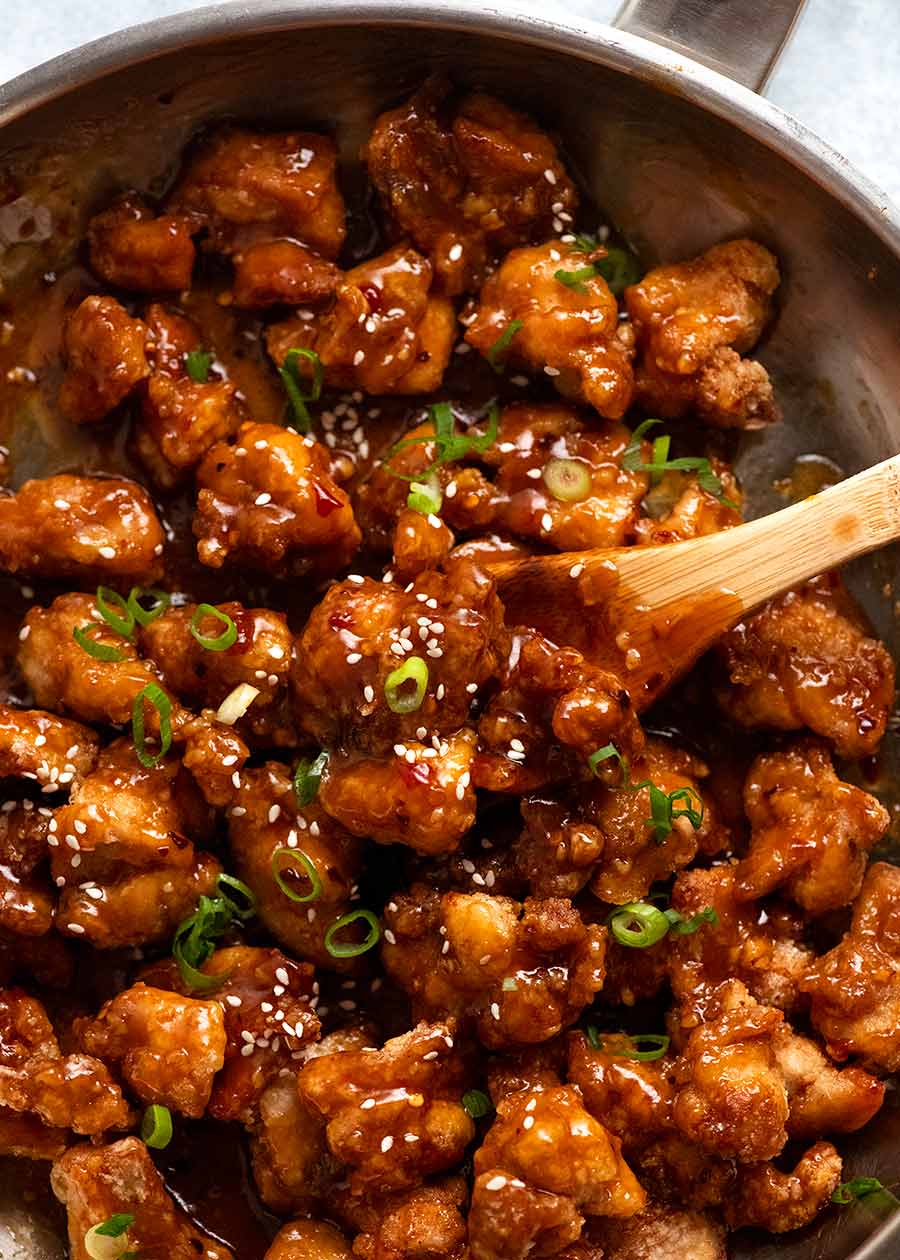General Tso's Chicken is a popular Chinese-American dish that has become a staple in many Chinese restaurants across the United States and other parts of the world. The dish is named after General Tso Tsung-tang, a famous Chinese military leader from the Qing Dynasty, although there is little evidence to suggest that he actually had anything to do with the creation of the dish. General Tso's Chicken is typically made by deep-frying chicken that has been marinated in a spicy and sweet sauce made with soy sauce, vinegar, sugar, and chili peppers. It is then served over a bed of steamed rice and garnished with green onions or sesame seeds. The dish is known for its crispy texture and bold flavors, and has become a favorite among many Chinese food enthusiasts.

Prep: 15 mins
Cook: 10 mins
SAUCE/CHICKEN MARINADE:
- 3 tbsp soy sauce - light or all-purpose (NOT dark soy, Note 1)
- 1 tbsp hoisin sauce
- 1 tbsp rice vinegar (sub white wine vinegar)
- 2 tsp chilli paste , any (Sambal Oelak is great)
- 1 tsp sesame oil toasted preferably (Note 6)
- 3 tbsp brown sugar
- 1 tbsp cornflour/cornstarch
- 3/4 cup chicken stock/broth , low sodium
CHICKEN:
- 600g/ 1.4 lb chicken thighs , boneless skinless, cut into 2.5cm / 1" pieces (breast / tenderloin - Note 2)
- 1 tsp ginger , finely grated
- 1 tsp garlic ,finely grated
- 1 cup cornflour/cornstarch (Note 5)
- 1 - 4 cups oil, for frying (peanut, vegetable or canola; Note 4)
STIR FRY SAUCE:
- 2 tbsp oil (peanut, vegetable or canola)
- 2 tsp ginger , finely chopped (Note 3)
- 2 cloves garlic , finely chopped (Note 3)
- 1/2 teaspoon red chilli flakes (red pepper flakes)
GARNISHES (AT LEAST 1 RECOMMENDED):
- Finely sliced green onion
- Sesame seeds
Instructions
- Sauce-Marinade: Mix the soy, hoisin, vinegar, chilli and sesame oil.
- Marinate Chicken: Take out 2 tablespoons of Sauce-Marinade and mix with chicken. Add ginger and garlic to chicken, mix, then marinate 30 minutes.
- Dust chicken: Add cornflour into chicken and toss to coat, ensuring pieces are separated so they get fully coated.
- Shake off excess: Tip into a colander and shake to remove excess cornflour (or grab handfuls, shake so cornflour falls through your fingers).
- Finish Sauce: To the remaining Sauce-Marinade (that you made in Step 1), add sugar and cornflour. Mix, then add chicken stock and mix.
- Heat oil: Heat 2 cm / 4/5" oil in a deep skillet (or large pot - whatever you’re comfortable with) to 200°C/390°F. To use less, see Note 4.
- Fry: Cook chicken 3 minutes, turning halfway, until golden and crispy. Drain on paper towel lined plate.
- New / clean skillet: Discard oil, wipe skillet and return to heat. Or use another large skillet.
- Stir Fry Sauce: Heat oil in a large skillet over medium heat. Add garlic, ginger, chilli flakes, saute 30 seconds until garlic is light golden. Add Sauce, bring to simmer and stir occasionally until it thickens enough that you can draw a path across pan base.
- Toss! Add chicken, toss to coat quickly - the quicker you are, the crispier the chicken stays! Transfer to serving plate, garnish and serve immediately with your rice of choice.
NUTRITION INFORMATION:
Tips:
- Use boneless, skinless chicken thighs for the best texture and flavor.
- Coat the chicken in cornstarch before frying to create a crispy crust.
- Fry the chicken in small batches to prevent the oil temperature from dropping too much.
- Use low-sodium soy sauce to control the saltiness of the dish.
- Adjust the spiciness to taste with red pepper flakes or chili paste.
FAQ:
Can I use chicken breasts instead of chicken thighs?
Yes, you can use chicken breasts instead of chicken thighs, but the meat may be drier and less flavorful.
Can I bake the chicken instead of frying it?
Yes, you can bake the chicken in the oven at 400°F (200°C) for 20-25 minutes until crispy and cooked through.
Can I make this dish in advance?
Yes, you can make the sauce in advance and store it in the refrigerator for up to 1 week. However, it's best to fry the chicken just before serving to keep it crispy.
Storage:
- Let the chicken cool to room temperature before storing it in the refrigerator or freezer.
- Store the chicken and sauce in separate airtight containers to prevent the chicken from becoming soggy.
- To reheat the chicken, place it in a preheated oven at 350°F (175°C) for 10-15 minutes until heated through. Alternatively, you can reheat it in a pan over medium heat with a little oil.
- To reheat the sauce, simply warm it up in a pot over low heat, stirring occasionally.
